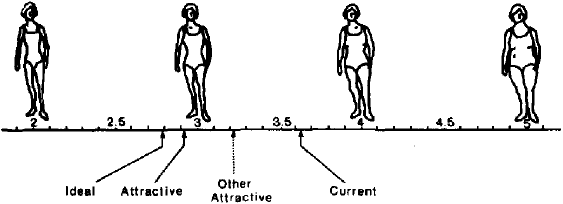The body mass index (BMI) is a measure of how much weight is carried with respect to height. It is computed by dividing the weight in kilograms by the square of the height in meters, i.e., its unit is kilograms per meter squared, though the unit is usually omitted. There are numerous BMI calculators (e.g., here) that people can use to figure out their BMI without doing any arithmetic.
The utility of BMI lies in it being a good proxy for percentage body fat at the level of the general population in epidemiological studies since it is not feasible to individually measure body fat levels in a large number of participants. However, BMI will not be a good proxy for percentage body fat in a minority of individuals such as very muscular people.
In a sample of 300 fashion models, the average BMI was 17.57; see Tovee et al.(1). The average age of these models was not reported, but for 18-plus individuals, some relevant BMI thresholds pertaining to underweight for the general population of European ancestry are 18.5-19.0 for sub-normal body fat levels from a health perspective(2), 17 for compromised physical work capability(3) and about 20 from a psychological health perspective(4, 5). If the median age of the fashion models in Tovee et al.’s(1) sample was 16, then the central tendency of the sample would be to have a BMI at roughly the threshold of a sub-normal body fat level from a health perspective. For the general population of European ancestry, the thresholds corresponding to excess body fat are a BMI greater than 25 (overweight) and a BMI greater than 30 (obese).
The optimally rated BMI among young adult women in Western societies appears to be in the 19.5-20.5 range(6, 7). Men and women rate the attractiveness of women with respect to BMI similarly(7); also see a previously addressed study involving 3D figures. In the cited study by Tovee and Cornelissen(7; zip), the authors mention two studies by Fallon and Rozin that showed men and women judging the attractiveness of women's physique differently, and explained the discrepancy with their find of “no difference” in terms of Fallon and Rozin using crude line diagrams in front view only as opposed to actual pictures of women in front and side view. Just take a look at the crude sketches used by Fallon and Rozin:

In the image above, the women were asked to pick the figure that best described their physique (Current), the figure they believed is the ideal for their sex (Ideal) and the figure they believed men were most interested in (Attractive). In addition, men picked the figure they found most attractive (Other Attractive).
People in a number of non-white societies prefer heavier women than in the West; some examples include the Shiwiar (Native American)(8), the Hadza (Tanzania, Africa)(9) and the Sami (Northern Scandinavia)(6). The Sami are a mix of Europeans and Asians, with the European element predominating. The aesthetically optimum BMI among young adult women as rated by Sami men is about 25; see Swami and Tovee(6; zip).
The take home point is that both men and women in Western societies prefer a BMI in women that is clearly higher than the norm among high-fashion models, which is consistent with previously addressed surveys by ACNielsen and Rand and Wright.
References:
- Tovee, M. J., Mason, S. M., Emery, J. L., McCluskey, S. E., and Cohen-Tovee, E. M., Supermodels: stick insects or hourglasses?, Lancet, 350, 1474 (1997).
- James, W. P., and Francois, P. J., The choice of cut-off point for distinguishing normal body weights from underweight or 'chronic energy deficiency' in adults, Eur J Clin Nutr, 48 Suppl 3, S179 (1994).
- Durnin, J. V., Low body mass index, physical work capacity and physical activity levels, Eur J Clin Nutr, 48 Suppl 3, S39 (1994).
- Lundgren, J. D., Anderson, D. A., Thompson, J. K., Shapiro, J. R., and Paulosky, C. A., Perception of teasing in underweight persons: a modification of the perception of teasing scale, Eat Weight Disord, 9, 139 (2004).
- Ali, S. M., and Lindstrom, M., Socioeconomic, psychosocial, behavioural, and psychological determinants of BMI among young women: differing patterns for underweight and overweight/obesity, Eur J Public Health, 16, 325 (2006).
- Swami, V., and Tovee, M. J., Perceptions of female body weight and shape among indigenous and urban Europeans, Scand J Psychol, 48, 43 (2007).
- Tovee, M. J., and Cornelissen, P. L., Female and male perceptions of female physical attractiveness in front-view and profile, Br J Psychol, 92 Part 2, 391 (2001).
- Sugiyama, L., Is beauty in the context-sensitive adaptations of the beholder? Shiwiar use of waist-to-hip ratio in assessments of female mate value, Evol Hum Behav, 25, 51 (2004).
- Wetsman, A., and Marlowe, F. W., How universal are preferences for female waist-to-hip ratio? Evidence from the Hadza of Tanzania, Evol Hum Behav, 20, 219 (1999).
Comments
The truth? This site is run by a bunch of homophobes you can't see straight. And don't try and lecture me on aesthetics, I did a Masters in Fine Art from Yale and am a "lifetime-exclusive heterosexual", as you clowns would say.
Danny: Perhaps someone with an esteemed education like yours can explain why my B.S. meter is tripping after reading your comment.